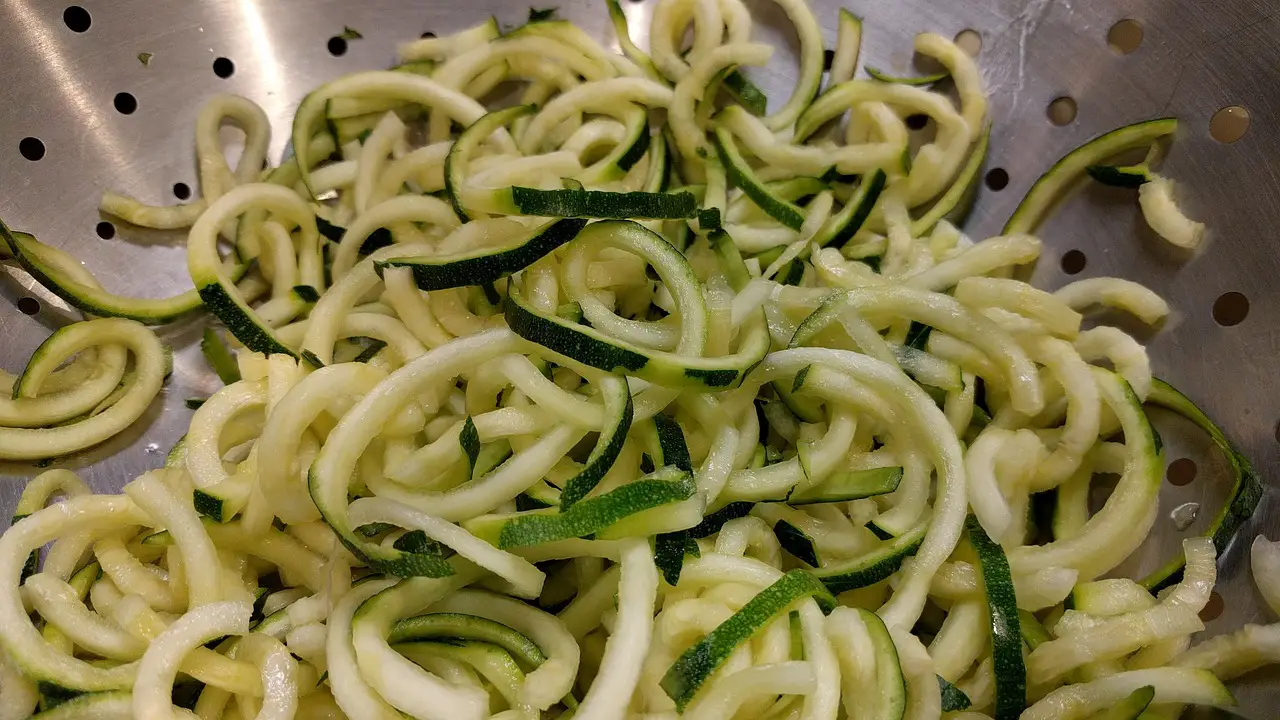Zoodles are a great way to add a healthier alternative to pasta. They are gluten-free and come in many shapes, sizes, and textures. They’re popular with children, too. If you want to store zoodles, the process is relatively easy. First, you need to cut the zucchini into smaller pieces. Using a spiralizer is the easiest way to do this. You can also use a food processor.
To preserve your zoodles, you need to freeze them in advance. This will help you reheat them whenever you need to. But how can you freeze zucchini noodles? Zoodles will keep well in the refrigerator for up to a week. When ready to prepare, thaw them in a bowl of cold water for about 30 minutes.

What are Zoodles?
Summer squash of the type of zucchini is used to make zoodles, a sort of pasta. Zoodles are created by spiralizing zucchini into long, thin noodles using a spiralizer. For people who want to eat more veggies, eat fewer carbohydrates, or avoid gluten, they are a well-liked substitute for regular pasta.
They are frequently used in recipes like stir-fries, salads, and pasta sauces and can be served either raw or cooked. Zoodles are commonly considered a healthier alternative to standard pasta due to their reduced calorie and carbohydrate content.
How to Freeze Zoodles?
How to freeze zoodles is as follows:
Wash and pat the zucchini dry. The zucchini should be washed and dried with paper towels.
Spiralize the zucchini: Turn the zucchini into long, thin noodles using a spiralizer.
Blanch the zoodles: To keep the zoodles’ texture and color, blanching involves quickly boiling them. Water should be brought to a boil before the zoodles are added. The zoodles should then be drained and placed in ice water to stop cooking.
Dry the zoodles: After they have cooled, gently pat the zoodles dry using a paper towel. This will prevent freezer burn, and the zoodles won’t stick together when frozen.
Transfer the zoodles to airtight, freezer-safe containers or bags to pack them. When sealing the containers or bags, squeeze out as much air as possible. The date and contents should be written on the containers or bags.
Put the containers or bags in the freezer and keep the zoodles until you need them. Zoodles can be stored in the freezer for 4-6 months.
By following these instructions, you can freeze zoodles and use them whenever you want as a low-carb, nutritious alternative to spaghetti.
How to Thaw Frozen Zoodles?
How to defrost frozen zoodles is as follows:
Zoodles should be taken out of the freezer. Frozen zoodles should be removed from the freezer and left in the container or bag for a few minutes to come to room temperature.
Run warm water over the zoodles: To thaw zoodles more quickly, put them in a colander and cover them with warm water for a few minutes.
Zoodles in the microwave: You can also microwave them for 1-2 minutes on defrost mode in a microwave-safe dish if you need to thaw them out quickly. To achieve even thawing, occasionally stir the zoodles.
Drain the zoodles: After defrosting, lay the zoodles on paper towels or in a strainer to remove any extra water.
Using zoodles, The zoodles can be used in your favorite recipes once they have thawed. They can be consumed raw, sautéed, or added to salads, spaghetti sauces, and stir-fries.
These instructions will help you quickly and efficiently thaw frozen zoodles without affecting their texture or flavor.
How to Preserve Zoodles?
This is how to keep zoodles:
Zoodles that are fresh and haven’t been cooked or frozen should be kept in the refrigerator for up to 3–4 days in an airtight container. To avoid the zoodles becoming slimy or growing mold, be careful to dry them completely after washing.
Cooked zoodles: Cooked zoodles can be kept in the fridge for up to 3–4 days in an airtight container. Simply heat in a microwave or a pan until warm to reheat.
Zoodles that have been frozen should be transferred to sealed freezer-safe containers or bags for storage. Thaw the zoodles as the prior solution instructed when ready to utilize them. Freeze for up to 4-6 months after marking the bags or containers with the date and contents. When prepared to use them.
According to these straightforward storage instructions, you can keep your zoodles crisp and prepared for use whenever you need them.
What are the Different Methods of Reheating Frozen Zoodles?
How to thaw frozen zoodles is as follows:
- Unfreeze the zoodles: Make care to defrost the zoodles before reheating them. This can be accomplished by putting them in warm water, heating them in the microwave, or letting them thaw at room temperature.
- Heat in a pan: Heat a tiny quantity of oil in a big skillet over medium heat to reheat in a pan. It should take two to three minutes. When the zoodles have been completely thawed, add them and boil them while stirring occasionally.
- Microwave: Thawed zoodles should be put in a microwave-safe dish and covered with a lid or plate to reheat in the microwave. Stir after each interval of 30 seconds in the microwave on high until the zoodles are thoroughly heated. It should only take a few seconds.
These are quick and simple techniques for reheating frozen zoodles so that you can enjoy them as a nutritious and delectable side dish or ingredient.
How to Make Zoodles at Home?
How to make zoodles at home is as follows:
- Gather the tools: To make zoodles, you’ll need a spiralizer, julienne peeler, or mandoline.
- Pick the ideal zucchini: Choose 7-8 inches long, firm, straight zucchini as your selection.
- Get the zucchini ready. To make two manageable pieces, trim the zucchini’s ends and cut it in half crosswise.
- Slice a zucchini half, then set one half on the spiralizer’s prongs. Spiralize: Attach the spiralizer to a cutting board. To create zoodles out of spiralized zucchini, turn the handle. Repeat with the other half of the zucchini.
- Cook your zoodles by sautéing them in a pan with a little oil or heating them in the microwave for one to two minutes. Additionally, you may use them uncooked in salads or as a low-carb substitute for spaghetti.
You may make zoodles in the convenience of your home by following these steps. Enjoy them as a tasty and healthy substitute for regular spaghetti.
What is the Healthiest Way to Consume Zoodles?
- Eat them uncooked or barely cooked: Zoodles maintain most of their nutritional value when consumed raw or cooked for a brief period. Zoodles can be used either raw or minimally cooked. Zoodles can be microwaved or sautéed. Here are some pointers for eating zoodles in the healthiest way possible:
- Add lean protein to the dish: To improve satiety and supply important nutrients, serve your zoodles with a poor protein source, such as grilled chicken or tofu.
- Eat a lot of vegetables. To improve your zoodle dish’s fiber and nutritious value, add extra vegetables like cherry tomatoes, bell peppers, or mushrooms.
- Use a low-fat sauce or dressing: Choose a low-fat sauce or dressing like tomato sauce or pesto made with heart-healthy components to keep your zoodle meal low in calories.
- Limit cheese: While it can give zoodle recipes depth and richness, cheese is also high in calories and saturated fat. Choose low-fat cheeses or use them sparingly.
Using these suggestions, you may add nutrition and satisfaction to your zoodle recipes without compromising flavor or enjoyment.
How to Identify Zoodles are Gone Bad?
Here are several methods for determining when zoodles have become nasty.
- Smell: Fresh zoodles ought to smell fragrant and light. They probably went rotten if they smelled sour or odd.
- Presentation: New zoodles should be firm, bright green, and free of browning or yellowing stains. They are past their prime if they appear slimy or mushy.
- Zoodles that are still fresh should have a firm, crisp texture. They might not be suitable for eating if they are limp or soft.
- Taste: Fresh zoodles should have a delicate flavor that is just a little bit sweet. They have probably gone bad if they taste harsh or sour.
Utilize your senses and throw away any zoodles that have gone nasty.
What are the Side Effects of Consuming Spoiled Zoodles?
Zoodles that have gone bad can cause food poisoning and have several unpleasant side effects, including:
- Nausea and diarrhea
- Diarrhea
- Constipation and cramping
- Reduced appetite
- Dehydration
- Headache
- Fatigue
- Weakness
- Muscle pain
Zoodles should always be handled and stored properly to avoid spoiling and lower the chance of contracting a foodborne illness. You should get medical help immediately if you believe you may have eaten spoiled zoodles.
Conclusion
Zoodles can be frozen, but they will lose their texture and taste as time passes. They will become soggy and mushy if you don’t freeze them immediately. You’ll want to store them in a freezer-friendly bag for the best results. These bags help to keep the zoodles from sticking together.
For up to a week, zoodles keep well in the refrigerator. Simply defrost them in a dish of cold water for about 30 minutes before you cook them. The zoodles should be cleaned after thawing. You can add salt, but not right away. Noodles that have been oversalted may become mushy.
